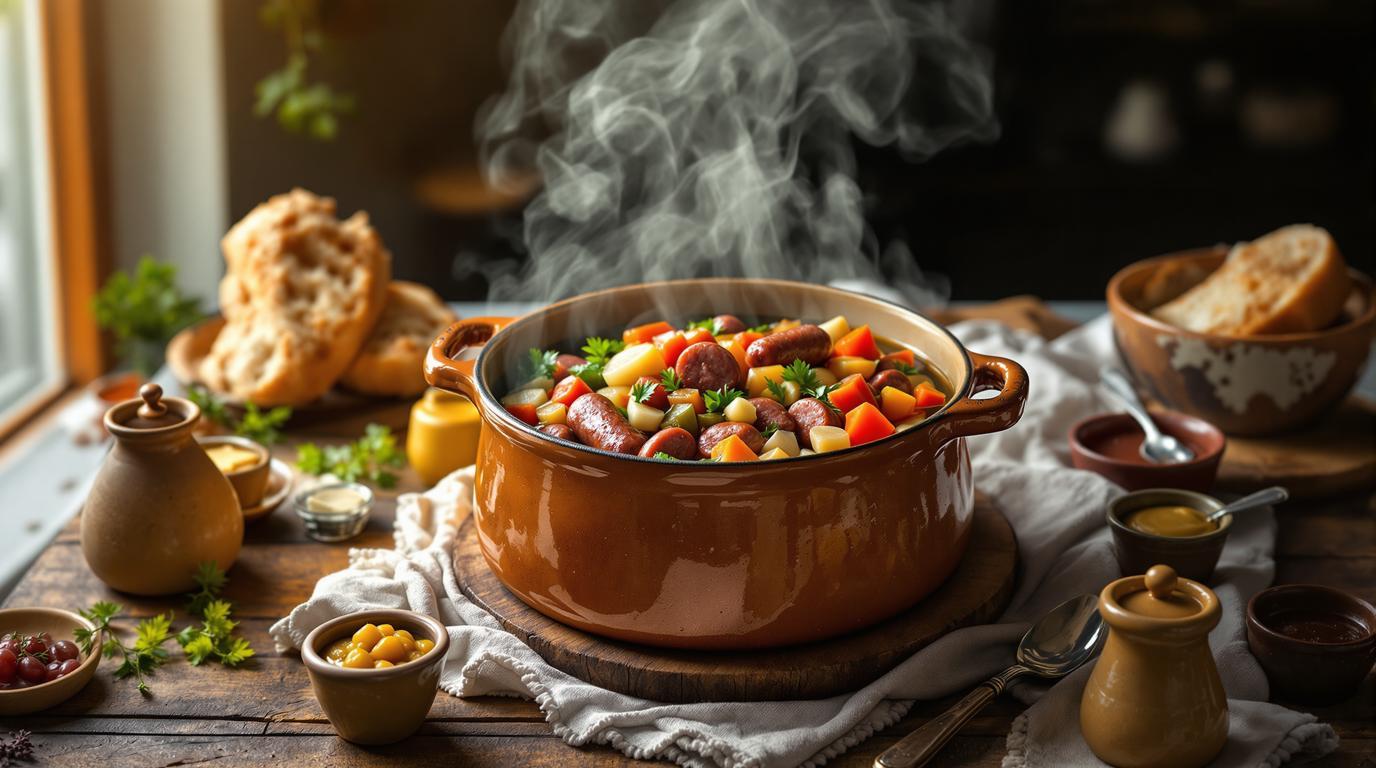There’s something profoundly comforting about a steaming pot of Potée de Légumes d’Hiver on a cold winter evening. My grandmother taught me this dish when I was just tall enough to peek over her stovetop, and the memory of her wooden spoon tapping against the edge of her earthenware pot still brings me comfort. This peasant stew originated in rural France where families would create hearty one-pot meals using whatever winter vegetables and preserved meats they had stored away. The magic happens in the slow simmering, where humble ingredients transform into something truly extraordinary.
The Story Behind French Winter Vegetable Potée
Like many traditional French dishes, the potée varies dramatically from region to region. In Burgundy, they add petit salé (salt pork), while the Auvergne version incorporates palette of pork and Montbéliard sausages. What unites all variations is the principle of slow-cooking seasonal vegetables until they create a harmonious, soul-warming broth.
My version is inspired by my grandmother’s recipe from eastern France, where smoky Morteau sausages infuse the vegetables with deep flavor. During the harshest winter months, this was our Sunday dinner – economical, nourishing, and bringing the whole family together around one generous pot.
Essential Ingredients
For 6 servings:
- 4 Morteau or smoked sausages (about 1 lb/450g)
- 1 green cabbage (2 lbs/1 kg), quartered
- 6 medium potatoes (1.5 lbs/700g), peeled and halved
- 4 carrots (1 lb/450g), peeled and cut into large chunks
- 2 leeks, white and light green parts only, cleaned thoroughly
- 1 onion, peeled and quartered
- 3 garlic cloves, peeled
- 1 bouquet garni (thym, bay leaf, parsley tied together)
- Salt and freshly ground pepper
Don’t have Morteau sausages? Any good-quality smoked sausage will work beautifully. The key is finding something with robust flavor that can stand up to the long cooking process. Polish kielbasa makes an excellent substitute that’s widely available.
Step-by-Step Instructions
1. Begin by lightly browning your sausages in a large Dutch oven or heavy-bottomed pot over medium heat. This quick step adds tremendous flavor complexity. Remove and set aside.
2. Optional but recommended: Blanch the cabbage quarters in boiling water for 5 minutes, then drain. This removes some of the bitter compounds and helps the cabbage absorb other flavors more readily.
3. In your cooking pot, layer the onion, leeks, cabbage, and carrots. Add the bouquet garni and garlic cloves.
4. Place the sausages on top of the vegetables, then add enough cold water to just cover the ingredients. Don’t add salt at this stage – the sausages will release salt as they cook.
5. Bring to a gentle boil, then reduce to a simmer. Skim any foam that rises to the surface. Cover and cook for about 60 minutes.
6. Add the potatoes and continue cooking for another 30 minutes, or until the potatoes are tender when pierced with a knife.
7. Taste the broth and adjust seasoning only at the end.
Chef’s Note: The vegetables should be thoroughly cooked but still maintain their shape. Each vegetable contributes to the broth, creating a complex flavor profile that can’t be rushed. This is slow food at its finest – patience yields perfection.
Chef’s Secret Techniques
The magic of potée lies in layering. Place denser vegetables like cabbage and carrots at the bottom where they’ll cook slowly in the liquid. The sausages go on top so their flavorful fat melts down through the vegetables.
Never boil your potée aggressively – a gentle simmer ensures the vegetables absorb flavor without falling apart. My grandmother would say, “Let it whisper, never shout.” This means tiny bubbles barely breaking the surface.
I check doneness with a small sharp knife rather than a fork – it gives you a better sense of when vegetables are tender without being mushy.
Serving & Presentation Tips
Traditionally, potée is served in shallow bowls with some of the flavorful broth. I like to present the whole pot at the table, lifting the lid for that dramatic release of aromatic steam that instantly transports everyone to a French countryside kitchen.
Pair with a crusty country bread and salted butter, plus small dishes of cornichons and Dijon mustard on the side. A robust French beef stew shares similar warming qualities, while Hungarian goulash offers another take on hearty winter cooking.
For dessert, consider something contrastingly light like homemade cream puffs.
This humble dish reminds us that cooking isn’t always about fancy ingredients or complicated techniques. Sometimes, it’s simply about honoring traditions, understanding how flavors develop over time, and creating something that nourishes both body and soul. Just as my grandmother’s potée warmed our family through countless winters, I hope this recipe brings the same comfort to your table.
